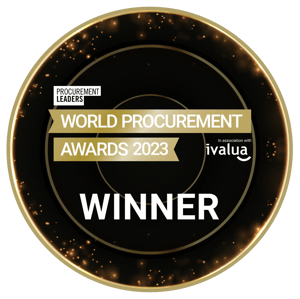Recently, we hosted a webinar with The Hackett Group and Mondelez on whether to build or buy your procurement analytics solution. The Hackett Group provides expert insights and intellectual property to help organizations improve their performance in procurement, finance, and supply chain management. Mondelēz International owns iconic brands like Oreo, Cadbury, and Toblerone and is known for its innovative approach to procurement digital transformation and supply chain management.
If you're building in-house capabilities or looking to buy from an external solution provider like Sievo, everyone should be aware of the real costs of these choices. You can watch the full webinar recording below:
This blog will cover some of the key themes from the webinar, provide additional context from original research by the Hackett Group, and explain 4 potentially unseen hidden costs of building in-house procurement analytics. You can also jump straight to the form to download our in-depth guide on in-house analytics versus Sievo.
TCO of In-house analytics vs. specialized solutions
Gartner defines total cost of ownership (TCO) as a comprehensive assessment of information technology or other costs across enterprise boundaries over time. Below, you’ll see our summary comparing the 3-year TCO of a bought service and a built ("DIY") solution. In the long run, the differences in costs can be staggering.

Building an in-house procurement analytics tool involves developing a custom system tailored to an organization's needs and processes. Organizations often use Business Intelligence (BI) tools like PowerBI or Tableau, combined with data processing languages like SQL, Python, or R.
Purchasing a specialized procurement analytics solution, like Sievo, involves selecting third-party software tailored specifically for procurement data analysis. These solutions streamline procurement processes, enhance data visibility, and provide actionable insights without extensive internal development.
Whether you're considering:
- the overwhelming cost of data management,
- the complexity of data architecture and security,
- the ease of accessing insights,
- how to synergize with market developments, or
- how to expand your knowledge base with community data,
A lot goes into the TCO argument.
To maintain an agile operating model, procurement leaders must keep pace with the accelerating market speed, leveraging a broad and diverse ecosystem of value-driving partnerships. In the words of JP Teppala, Chief Customer Officer at Sievo, “Software gets old, you need version upgrades, and you need innovation. These add up over time.”
For the rest of this blog, we'll dive deeper into four key areas that most internal IT teams and procurement organizations may overlook in their decision-making.
1. Long-Term Maintenance and Development Costs
When we surveyed webinar participants, 34% said long-term maintenance and development costs were the most overlooked TCO assessment when comparing build versus buy.

In the context of an in-house procurement analytics solution, maintenance and development costs are made up by monthly in-house data processing, future tool development, and many smaller support issues usually involving IT teams.
You'll be left with the manual process to address data quality independently when using an in-house tool. This includes much-needed data cleansing and validation.
Using external data consultants might work in a short period. Still, over the years of using an in-house tool, you'll waste countless hours on monthly spend classification and supplier consolidation—usually manually.
The heavy workload needed to cleanse and validate data delays procurement processes and, thus, the organization's overall efficiency. This strain on resources can increase human error, slow down procurement cycles, and limit the ability to respond agilely to market changes or internal demands.
Implementing an in-house tool involves many stakeholders, and projects can take years. As additional business use cases are required, more resources are poured into developing new dashboards, solutions, and data connections, exacerbating the workload.
Therefore, a final tool is never finished developing and often lacks the scalability to handle growing data volumes and complexity, leading to further development.
2. Opportunity costs
During the webinar, Nitin Gupta (Senior Director, MDS Procurement Global IT & Digital Transformation Lead at Mondelēz International) highlighted a critical point:
"In Mondelēz, when we looked into that kind of opportunity cost [of building in-house procurement analytics], that was like 5X [...] just lost as money on the table from a CPO perspective."
From a raw savings point of view, you are leaving behind millions in savings during the years spent developing an in-house tool. Strategic initiatives and opportunities that have been identified may never be seen while developing a new tool.
Once you can onboard Sievo, you'll find savings opportunities worth 3 to 11% of your total yearly spend—if you multiply that figure by any number of years used developing a new solution, the lost potential savings are astronomical.
When IT and Procurement teams spend hours of productive time on manual processes, struggling to find opportunities and correct other daily errors, they detract from actual strategic initiatives. The bottom line is that onboarding a specialized solution that can provide advanced insights quickly will greatly improve your ability to take action sooner rather than later.
3. Data Quality Management and Cleansing Costs
In-house solutions are prone to manual data entry errors and inconsistent data formats. Common challenges among organizations include no single source of truth, manual data manipulation, lack of trust in data, and difficulty converting data into actions.
As Chris Sawchuk (Principal and Global Procurement Advisory Practice Leader at Hackett Group) stated:
“If what you get back [from data insights] is not accurate, you're going down a path of building distrust within the organization on the data that you have.”
Unlike more specialized providers, which leverage AI and procurement-specific industry knowledge, as well as anonymized community data from other leading global companies, in-house analytics tools require building internal data capabilities from scratch. This requires a lengthy learning curve.
JP Teppala added during the webinar that “it's not just getting things right one time, it's being able to consistently deliver good quality and really build the relationship, build the trust.”
If you've ever heard the expression “garbage in, garbage out,” that makes a lot of sense for in-house tools. But for specialized procurement providers like us, we have worked with data of all quality and still manage to quickly bring confidence in the quality of your procurement data insights—continually, without further effort from you.
4. (Missing out on) the power of community
If you watch our webinar, you’ll hear how this is the biggest cost yet. You are still developing in a bubble even with the perfect in-house tool. While third-party proprietary data could enrich your procurement insights, how can you compare yourself to benchmarks from other leading organizations? Keeping up with state-of-the-art technology and innovation is far beyond the capacity of most in-house development teams.
Are you capable of investing in constant updates as procurement technology advances at a rapid pace?
In the words of JP: “The beauty is that when we have co-innovation with 200+ customers today, then each and every single one of you can benefit from what the others think as well.”
This is the golden egg that specialized providers bring. Here's one poll we ran that confirmed this:

For instance, Sievo has the largest R&D budget in the procurement analytics tech market. With our AI-dedicated team and 200+ global customers, we constantly develop our product with clients, focusing on closing the data-to-action gap. Our cross-customer community insights bring you closer to procurement excellence with the ability to compare your payment terms to community benchmarks, use cross-customer service records to determine the correct supplier parenting, discover commonly used suppliers within the Sievo community, and more.
Read more about community data insights here.
As Nitin explained during the session:
“If 100 million suppliers are there on the Sievo platform, from a data point of view, I think this is a win-win. From a supplier perspective and us as Mondelēz, it's creating a platform where more suppliers can be discovered from the RFP perspective.”
Conclusion: Hackett Group findings
The Hackett Group's research on Digital World Class® spend analytics highlights several key findings that underscore the importance of robust spend visibility and the pitfalls of relying on in-house solutions.
Here's a summary of the key points and context on why the hidden costs and total cost of ownership (TCO) of in-house solutions should not be ignored:

Challenges with Current Solutions: A significant portion (34%) of procurement executives report that their current spend analytics technology falls short of expectations. Common issues include a lack of external data, manual data manipulation, and reliance on outdated or inflexible tools.
Spend Visibility and Performance: The research shows a strong correlation between high spend visibility and improved performance metrics. Organizations with Digital World Class® spend visibility experience significant improvements in cost savings (2.1x), return on investment (2.6x), cycle times (31% faster), and reduction in late deliveries (72%).
Leading Spend Analytics Capabilities: Advanced spend analytics capabilities, such as Community aggregated and anonymized data, Insight engines that generate recommended insights, and intelligent data connections, are crucial for achieving Digital World Class® performance.
With figures like these, in-house solutions like Excel, PowerBI, or Tableau may seem cost-effective initially, but they can significantly hold back procurement performance.
As we’ve shown, in-house tools face some major challenges that affect TCO:
- In-house tools are resource intensive: Maintaining and updating in-house analytics requires substantial internal resources, including IT support and data scientists, which can divert attention from core business activities.
- Lack of trust in data: In-house analytics tools often struggle to integrate diverse data sources, leading to data silos and fragmented insights. This can result in decision-making based on incomplete or inaccurate information, degrading trust in procurement.
- Opportunity costs: The time and effort spent on managing in-house tools could be better invested in strategic initiatives that drive value and bottom-line savings.
- Missing out on community insights: When you build in-house, you’re essentially blind to the market’s tech developments. By choosing an analytics solution, you’re gaining exponential insights into best-in-class procurement organizations.
This makes a compelling case for considering the full spectrum of costs associated with in-house tools and opting for a specialized solution. To learn more, check out our full-length report comparing in-house procurement analytics vs. Sievo.






